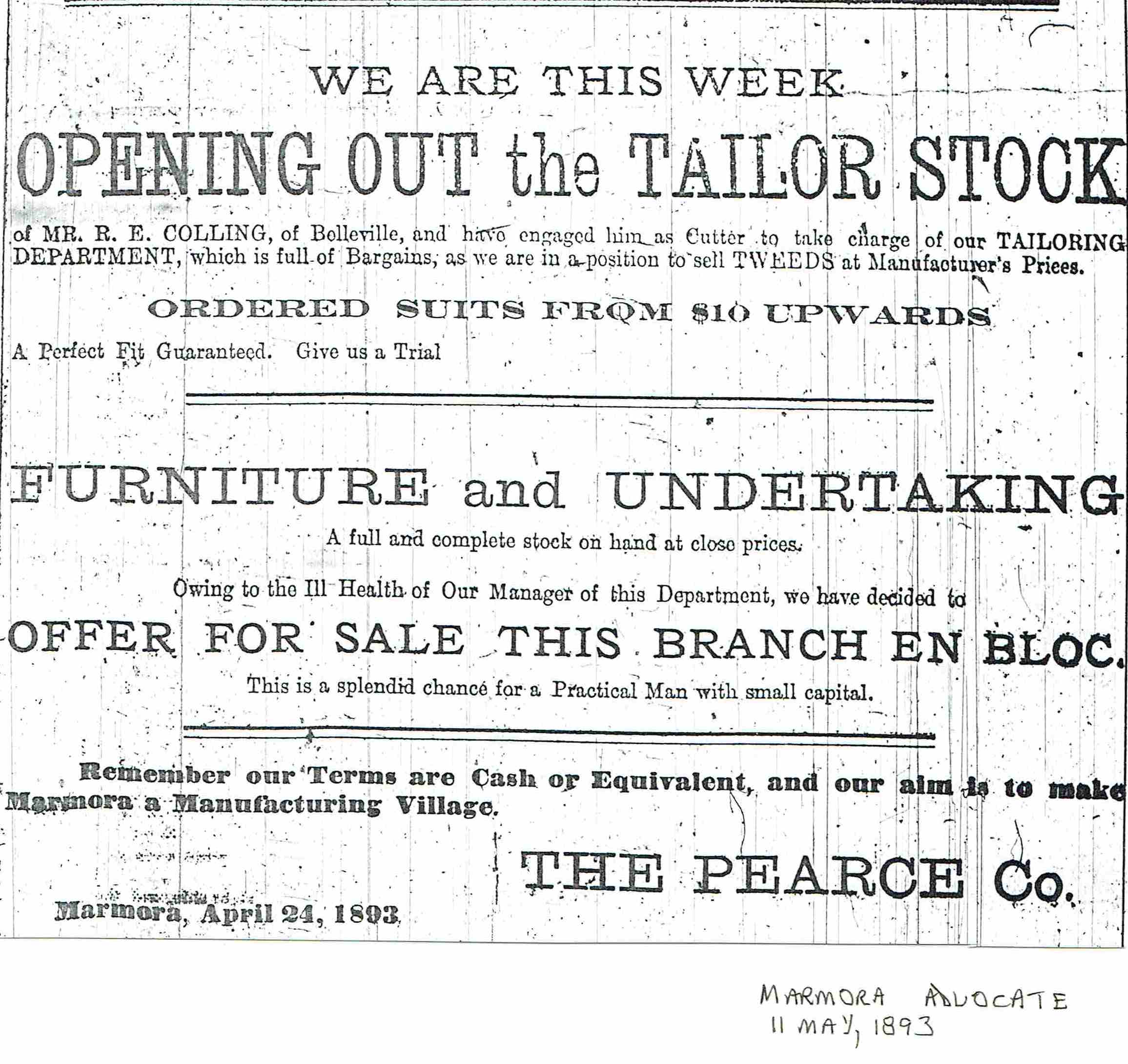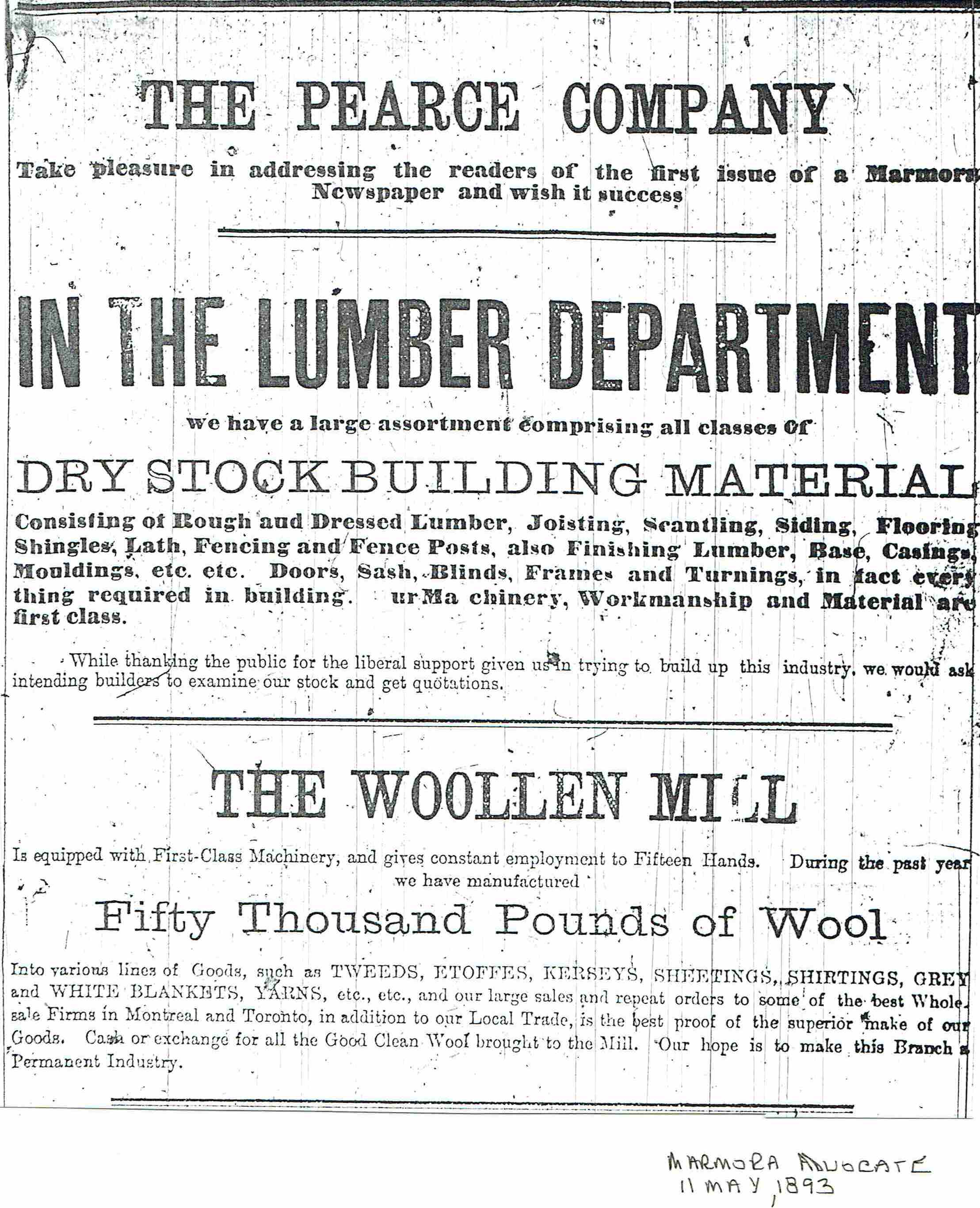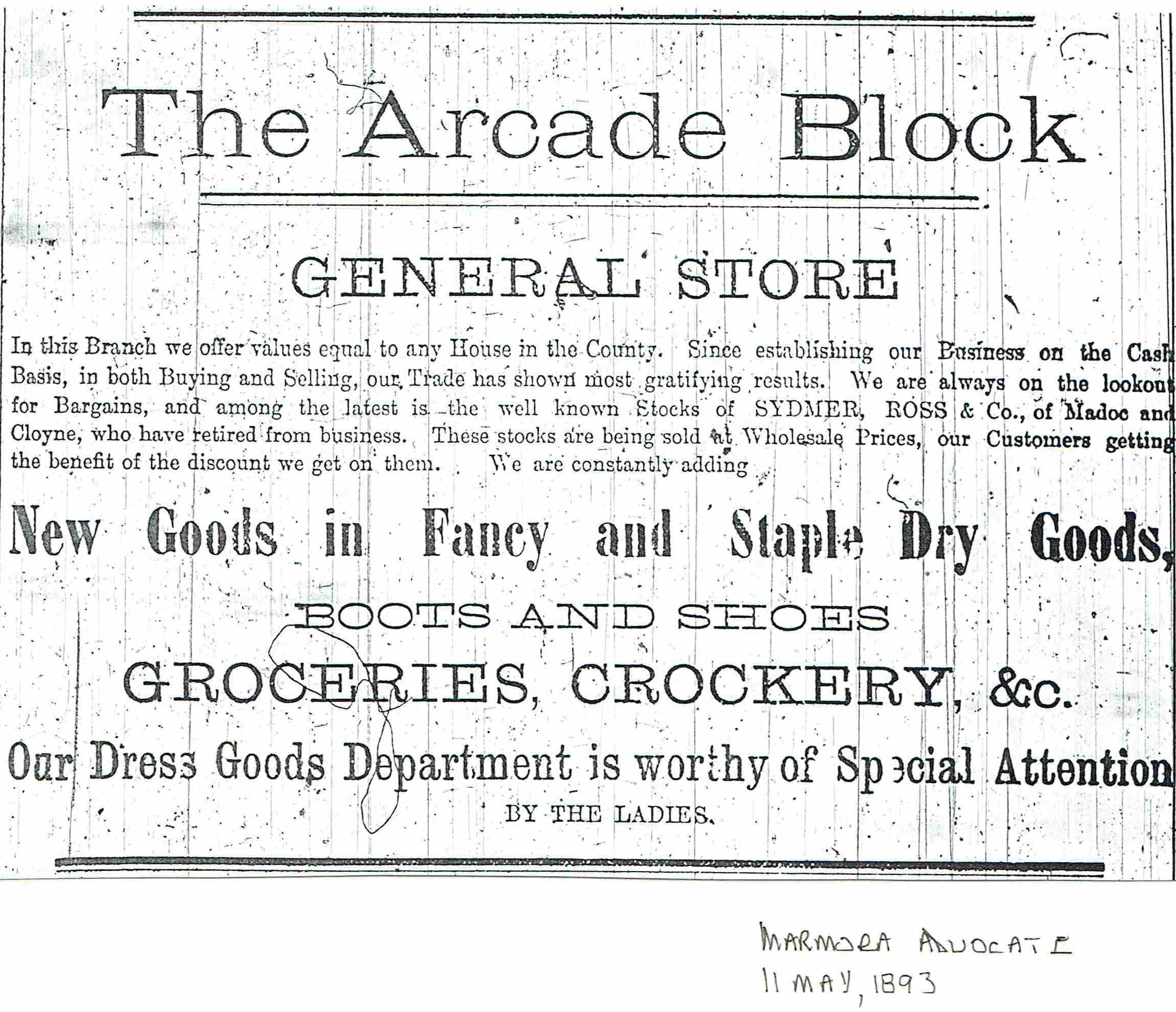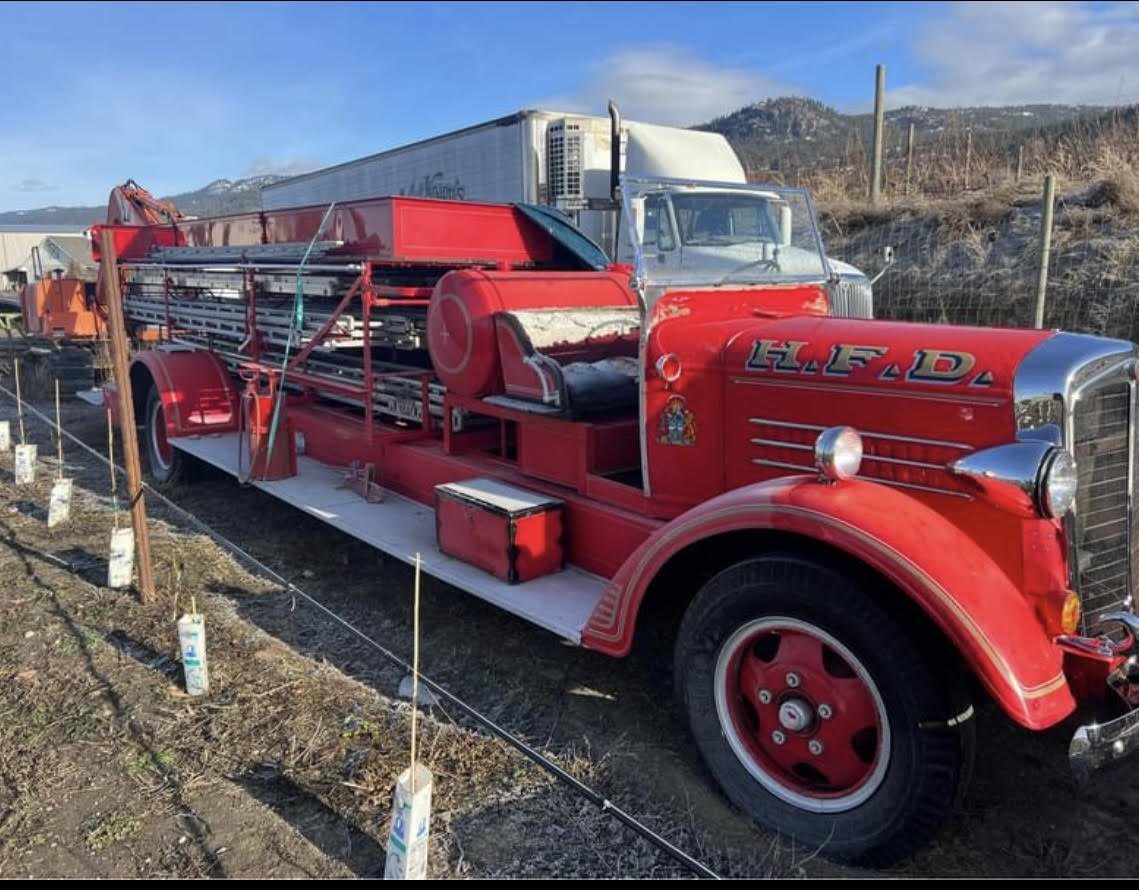Jones and hodge on Main Street McGill Street in the background
MAIN STREET
THE ORIGINAL BUSINESS SECTION
Starting in 1821, with the development of the Iron Works at the dam area, all of Marmora's business was taken care of by entrepreneurs on Main Street (explaining the name). We don't have very many details, but hope to build up an image of Marmora's first business section by slowing piecing together whatever information comes in.
1857-58 CANADA DIRECTORY
From the above 1857 directory we can see the importance of the iron furnaces, naming the lessee, William Evans, who employed a master miner, furnace keeper, a furnace manager and a forge manager, under whom worked hundreds of men as loggers, miners, barge crew, charcoal makers, limestone diggers, and iron workers . Surrounding the furnaces were businesses set up to meet the needs of the population of 400 (mostly men) - carpenters, hardware and dry goods, shoe makers, inn keepers, a grist mill, a postmaster, blacksmiths and carriage makers - all located on Main street.
By 1879, we know that businesses were moving to McGill Street and Forsyth Street, as indicated by the Directory of that year. See below.
One Main Street, on the north west corner of Main and Madoc Streets was a wooden frame building owned by Mr. James Wilkinson, a cobbler. It was the location of Mr. Sweet's bake shop, onto which he built and ice cream parlour in 1908. This building burned down in 1920, and Mr. Sweet moved his bakery to 1 Forsyth Street on the SW corner of Forsyth & Madoc.
Excerpt from Industrial Edition of Belleville Intelligencer 1914
The commercial interests of Marmora comprise no more Important factor of growth than that of the trade In bakery goods, bon bons etc. A prominent leading enterprise devoted to the trade here is the one conducted by Mr. Wm. Sweet.
'This business was established by its present proprietor fourteen years ago. He commenced operations with all the most advanced facilities for promptly supplying the trade. The premises located on Main street, Phone 29, are ample In area and thoroughly equipped throughout. Mr. Sweet Is a manufacturer of bread, buns, bakery goods and dealer In groceries and fruits In season, which are sold at wholesale and retail. Several bakers are employed and one wagon is In use for delivery purposes. A large and leading trade Is enjoyed and everywhere this establishment Is recognized as maintaining the highest standard that has always characterized its operations from the outset. Mr. Sweet the proprietor of this establishment has a wide experience In the lines carried. He is highly regarded in social and commercial life.
The lot was then purchased by Mike Kouri where he built a two storey frame and concrete block building in 1924. (Mr. Kouri and his wife were killed in a car accident in 1956.) Click here to read more about this building.
Pre 1920……..1 Main Street on the lower edge of this photo, with lynch’s store up the street. On the left is 3 Main Street, Dr. Henry Mitchell Jones.,s house (Photo donated by Linda Szmyr)
Next door, at 3 Main Street, was the residence and office of Dr. Henry Mitchell Jones(1844-1923), now the Merkely residence, where, on a painted wall you can just make out the Jones name. Dr. Jones died in 1923 and is buried in the Marmora Common Cemetery Sect. J - Row 10 - Plot 24, along with his sister and wife, Mary.
3 mAIN sTREET
In 1967, Margaret Monk wrote the following description:
Many small settlements came into being as a result of lumbering. In 1864 there were 49 families resident in the village.Most of the wage earners were involved in supplying services to the surrounding inhabitants. John Devlin, Thomas Price, Patrick Shea and Henry Weese were shoemakers. while DennisShannon was the village's tailor.
There were two blacksmiths- SimonArmstrong and Charles Clairmont. Thomas Warren was a carriage maker.James Ranney was a building contractor, G. L. Houston a carpenter,Francis Revois a shingle maker, and Lewis and Jerome Tallon were cabinet-makers.
Robert Wadsworth was a tinsmith. Dr. N. Powell operated a flouring mill and Levi Rose was a cooper. Land agents, mining company representatives, a division court clerk, a bailiff, and about three hotelkeepers and general merchants also lived in the village.
Grace Warren also described in 1967 the development north of 1 Main St, where Mr Wilkinson cobbled shoes:
"Farther north on the same side of the street was the Arcade Block, a little of the excavation may still be seen. It was built by Josiah.W. Pearce and was of long brick blocks with a verandah the entire width. At this point, I may say, it seemed to be the style for the stores to have a verandah across the entire length. It housed five stores and had 2 dwelling apartments upstairs. Pearce's reserved the north end for their general store and tailor shop.
Different businesses at different times were a shoe store under Mr. Powell, Dempsey's Bros. Stoves & Tinware before they built their block on what we now call Front Street, a flour and feed store run by M. Fidlar, an undertaking business and the Herald Printing Office in 1893, run by Zed Lafontaine.
1 mAIN sTREET
MARMORA'S FIRST STRIP MALL
The Arcade Block was a five store strip, occupying the space north from 5 Main Street to the corner at Reginald Street (Cutting Corner). Built by Josian W. Pearce, the big lumber baron in town, it housed two apartments on the second level, above the five businesses:-
The Marmora Advocate, run by Zed Lafontaine (1871-1947
A Harness shop run by Wm Albert Sanderson, who came to Marmora in 1902
M. Powell's Boot and Shoe Store
Dempsey Brothers Stoves and Tinware store
Roll and Stone Flour run by M. Fidlar
The whole block was burnt to the ground in May of 1905 and the occupants who remained on in business, seemed to move to our present Forsyth St .It is claimed that when the " Arcade Block " burnt so did all the earliest records of the Marmora Advocate & Herald. John Webb purchased the property where the Arcade sat and built his brick residence at 5 Main Street.
1893 FIRE INSURANCE MAPS
For closer viewing it will be necessary to right click and save to your computer, enlarging with your photo viewer.
Maps by Charles Edward Goad. Click here to read more about Goad.
5 mAIN sTREET
Farther up Main Street, was Joe Warren's Blacksmith Shop and residence.( 11 Main Street) Joe Warren was the 1st reeve of the Incorporated Village.
1893
The next house, although there is no evidence, may well have been a charcoal house for the Ironworks. The chimneys of the blast furnaces, into which the charcoal was to be dumped, would have risen up the cliff in the backyard of this house.
In the parkette to the north lie the footstones of the Pearce Company stone grist mill In this area the Pearces also maintained a sash and door factory,dry kiln and office, all later destroyed by fire. A story of wealth and woes, the Pearce Company was the backbone of Marmora prior to the turn of the century.
11 Main Street Home of E. Goddard, Blacksmith shop of Joseph Warren
View looking east across Crowe River, Pearce Lumber Mill & Presbyterian ChurchHUBBLE'S MILL IS THE WHITISH BUILDING ON THE FAR RIGHT, ORIGINALLY BUILT BY THE PEARCES. ALL OTHER BUILDINGS ARE PEARCE MILLS. THIS PHOTO IS TAKEN FROM THE WEST SIDE OF THE RIVER, AND SHOWS THE ORIGINAL LOCATION OF THE ONE OF THE DAMS.
1893
1893
1934 FIRE IN THE GRIST MILL
One of the worst fires to occur in Marmora in several years destroyed the big grist mill on Main Street early Monday morning. The fire was discovered about 8 a.m. by Doug Jones, who happened to be driving past and noticed the reflection of the fire on his wind shield. He stopped to investigate and found quite a fire in the basement of the mill. He first rushed to the residence of Clifford Spry and gave an alarm and then drove to the telephone office and roused Miss Mary Ryan, the night operator, who immediately called the Rectory. The fire alarm was soon ringing, but for some reason it was un- usually difficult to arouse most people and those who did turn out first didn't know where to look for the fire. As a result it was probably 15 or 20 minutes before the chemical engines reached the scene of the blaze and by that time the fire had assumed serious proportions.
About 5000 feet of lumber was stored in the basement of the mill, along with other material, and when the lumber caught fire it made a very hot blaze, which the chemical engines would not check. In some way one of the pulleys, which operate the fire shaft had been loosened so that it turned on the shaft and as a result it was impossible to get any water pressure to operate the fire hose, with only a small stream coming from the nozzle. By strenuous efforts the fire was prevented from spreading to the adjoining house or stable, but every- thing about the mill except the old stone walls was destroyed.
The mill was one of the oldest, as well as largest, buildings in Marmora and had been in operation for over fifty years. It had three stories, besides the basement, with a one story store house on the south side. It would be difficult to estimate the value of the building. To erect a building of equal size would probably cost $15,000. or more, but the value at the time of the fire would be a good deal less. The equipment which was destroyed would also cost over $1000. to replace. The Pearce Company had no insurance on the building or equipment.
For a good many years the mill was successfully operated as a flour mill. Among those who operated it as a flour mill being the late W. H. Hubbell. It had suffered from fire on previous occasions, but had always been restored and was generally enlarge or improved.
The first fire remembered was in 1884, when the building was badly damaged. A fire occurred while Mr. W. H. Hubbell was in operation but no serious damage was done at the time. The flour milling machinery was taken out a few months ago.
Mr. G. B. Airhart occupied the mill for several years, carrying on a flour and feed business and doing a large amount of grain grinding. He gave up the mill some six or more years ago and had taken it over again the latter part of last year. Fortunately his stock was comparatively low, one car had arrived, but was not unloaded, and another was on the way. Most of the feed in the bags was saved before the fire reached it. Mr. Airhart's loss is estimated at from $200. to $300. and was not covered by insurance.
There is very strong reason to believe the fire was of incendiary origin. It started in the basement of the mill where there was no stove, no electric wiring or anything .else to start a fire and where no one would have occasion to go on any legitimate business at that time. It is hard to believe anyone would be vindictive enough or degraded enough to deliberately set the mill on fire, under present conditions especially, but there doesn't appear to be any other explanation. The Provincial Police are investigating.
Marmora Herald January 13, 1934
MARMORA FLOUR MILLS.
Industrial Edition of the Belleville Intelligencer 1914
Prominent among the Industries carried on In Marmora and ranking with the most staple products in the manufacture of wholewheat flour, seed, bran, shorts, etc., is that conducted by Mr. W. H. Hubbell under the above title. This business Is an old established one and enjoys a widespread reputation throughout the surrounding county for the excellence of Its products.
The mill is a three story remodeled structure equipped with the most modern machinery and operated by two 54 hp water wheels and when running to full capacity the output is50 barrels of flour daily. The leading brands are Diamond, Forest King, Sovereign and Family Flours.
A large local trade is enjoyed which extends all over this and neighbouring counties and covers a radius of 75 miles. The business was established by Mr. W. Hubbell In 1898. He operated it for11? years. After several years absence he again assumed control In 1906. He is a man of first class business ability and is eminently adapted to conduct the affairs of this establishment with success and by his modern system of doing business he is winning the confidence and esteem of all having dealings with him.
THE GRIST MILL - HUBBLE, AIRHART AND LUMSDEN
According to the Marmora Herald on April 26. 1906 the machinery at the Marmora mill being completely overhauled.
1933
Pearce barns and sheds on the east side of Main Street, looking north up the Crowe River
16 Main Street - The Nichol Bakery
Sept. 5, 1907: Fire broke out in M. C. Johns' blacksmith shop on the east side of Main St. last Thursday night. The workshop was saved but a large storehouse belonging to the Gladney Estate was burned to the ground, but not until most of the contents, mostly salt, had been removed. There was no insurance and the building was of solid pine and one of the oldest in town.
The east side of Main Street consisted of a lot of sheds, barns and log storage units. At 16 Main St. stood the residence of Mr. Nichol. Arthur Sweet, a baker himself, wrote in 1967, "Mark Nichol, and later his son Charles, had a bakeshop there, and part of the equipment was still in the house when Mrs. Nichol was married (1904) The oven, which was of stone and brick construction, remained at the rear of the building until only a few years ago.
AND MORE RECENTLY?
1999 - Sheree Robson and the crew at the Cutting Corner moved from 2 McGill Street to the old Hydro office at 7 Main Street.
44 MAIN STREET
The Texaco Station located here was originally run by Billy Smith & his wife. His son Tom & his wife Mae, had a bit of a convenience store along with the gas station. In the later years Tom built the building where the real estate office is now & did minor repairs, oil changes etc. The next owners were John Gray & his wife Gladys. Their daughter, Judy Hammock would help out.
Peter Fudge writes: Mom and dad ran North End Variety in the early 90's. Located at the intersection of McGill and Main st. Closed down in '93 due to someone running into the gas pumps and causing an explosion.
Jackie Fraser Tom helped my mom and dad out tremendously. Dad always spoke very highly of Tom.
Dale Sopha: Me and Bob used to ride our bikes there, full speed down the hill for the best ice cream cone you could get. Not soft serve either!
Karen Paranuik: It was the best "ICE CREAM" in Marmora when I was a kid! 1968 and later.
Lisa Giroux-Belanger We used to walk down the street from my Grandmother's house - Marie Belanger- to get ice cream. I was very sad when it closed. Then it became a restaurant.
Lorrie Tannahill: I remember being given $1 from my mom (and my friends got the same from theirs) and we would walk from what used to be Riverview Crescent (now Fox Lane maybe?) where my grandmother lived. We would walk to the store all excited about what we were going to buy... . and waving to every car that would pass by because back then everyone waved to everyone whether they knew you or not - I really do miss that actually. Tony and Judy Hammock owned it back then. Tony was so much fun in the store when he was there and Judy was always so patient with us waiting while we tried to figure out what to spend our $1 on. Back when life was simple.... Can we some how go back to those days???
Terry Brown Best place to go if you wanted to work on your car and very resonable charge. Those were the days.
THE LAUNCH PAD AND FISHERMAN'S COVE
GEHAN - Woodworker and carriage maker from 1908 to 1956. While running a buiness behindwhich his house on Main Street (which house is unknown), he also ran a carriage and blacksmith buiness at 28 Forsyth.
NORTH END GAS & GOODIES
North End Gas and Goodies, formerly the Texaco Station, was and is now a Remax Real estate office owned by Francesca owned by Brad Campbell and Ken Ohno,
. In the photo below, the gas pumps were located in the bushes on the left. The building was later sold to Francesca Windover who ran a restaurant and an art gallery in this location, (See Launch Pad below) and later a real estate office.
44 Main Street with gas pumps now buried in the bushes at the left



















































